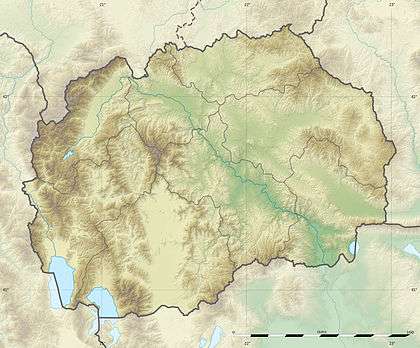Macedonian wine

The Republic of Macedonia produces wine on some 22,400 hectares (55,000 acres) of vineyards,[1] and the production was 108,100 tonnes in 2008.[2] There are also some additional 30,000 hectares (74,000 acres) of vineyards dedicated to table grapes. Red wine dominates the Macedonian wine production, with around 80 per cent.
Within the European Union, "Macedonia" (Μακεδονία) is a protected geographical indication (PGI) for wine from the Greek region of Macedonia.[3]
History
While part of Yugoslavia, Macedonia was a major producer of wine. In the 1980s, it accounted for around two-thirds of the Yugoslav wine production. After the breakup of Yugoslavia, the Macedonian wine production decreased dramatically, from 1.8 million hectoliters in the mid-1990s to 447,000 hl in 2002.[1]
Wine regions

Macedonia has three wine-growing regions:[1]
- Povardarie, in the valley of river Vardar, mostly around the towns of Negotino and Kavadarci. It is the most important region both in terms of quantity and wine quality.
- Pčinja-Osogovo, to the east on the border with Bulgaria.
- Pelagonija-Polog, around Lake Ohrid, to the west on the border with Albania.
Grape varieties
The grape varieties common in cultivation includes a large proportion of indigenous varieties and varieties common to Central Europe and the Balkans, as well as some international varieties. Red varieties include Vranec (the most common variety of Macedonia), Kratosija, Cabernet Sauvignon and Merlot. To be noted that Stanušina Crna is a variety of grape of Macedonian origin, capable of producing very high quality wines, very popular on domestic market, little known outside of its native country. White varieties include Smederevka, Welschriesling (usually referred to as Laški Rizling), Chardonnay, Sauvignon blanc and Žilavka[1]
References
- 1 2 3 4 Jancis Robinson, ed. (2006). "Macedonia". Oxford Companion to Wine (3rd ed.). Oxford: Oxford University Press. p. 414. ISBN 0-19-860990-6.
- ↑ "Wine production (tons)". Food and Agriculture Organization. p. 28. Retrieved 2011-02-11.
- ↑ e-bacchus: Μακεδονία
